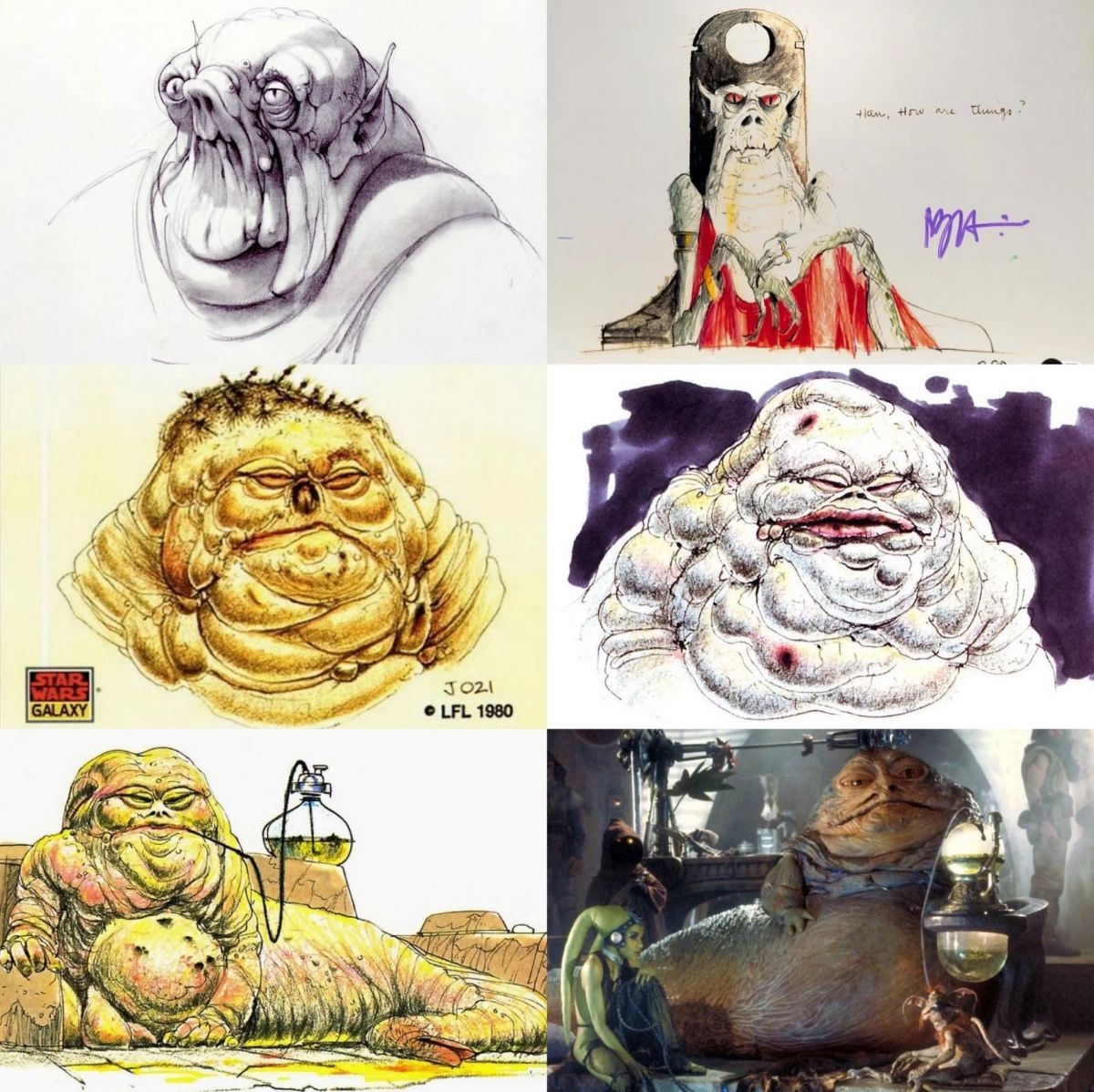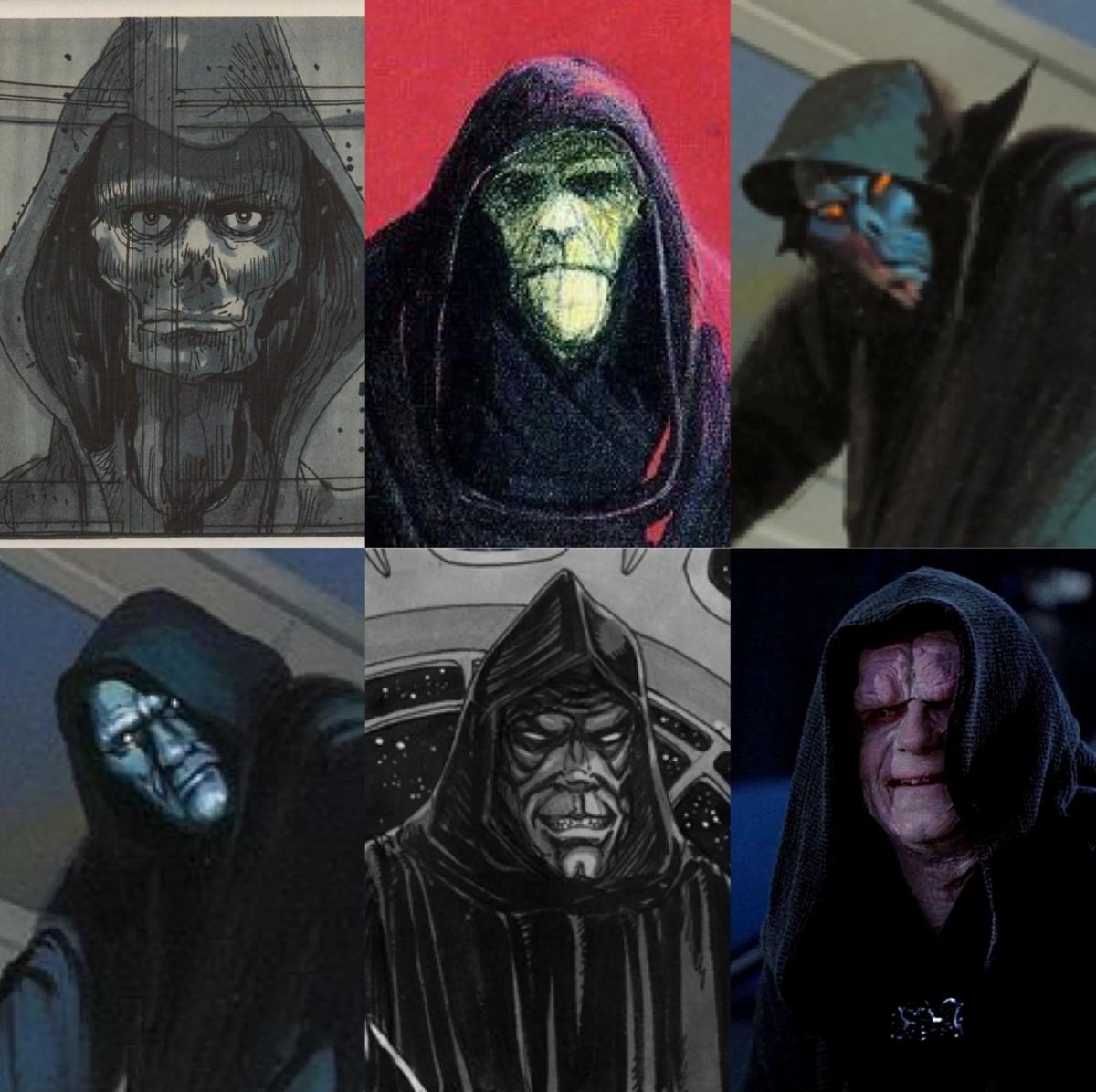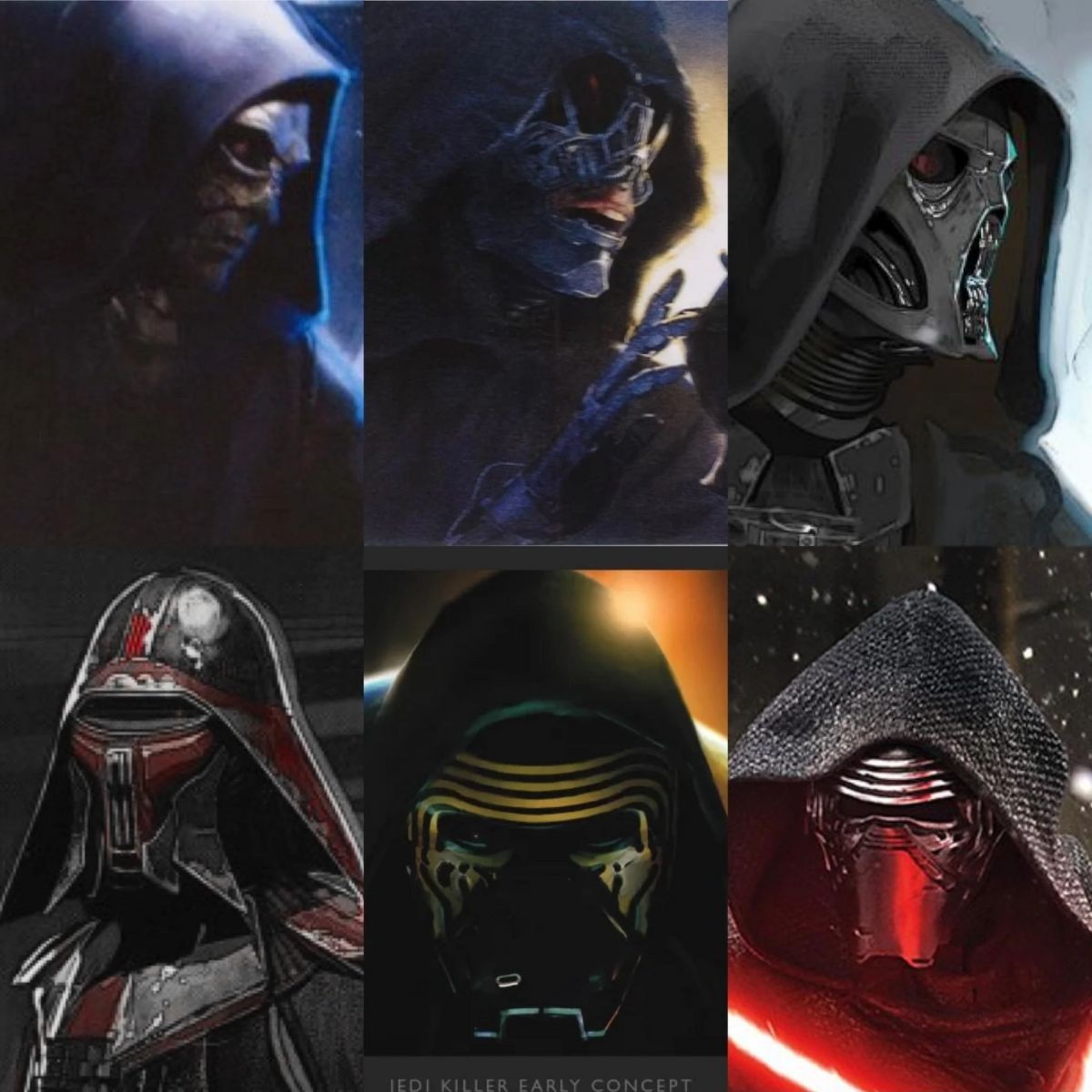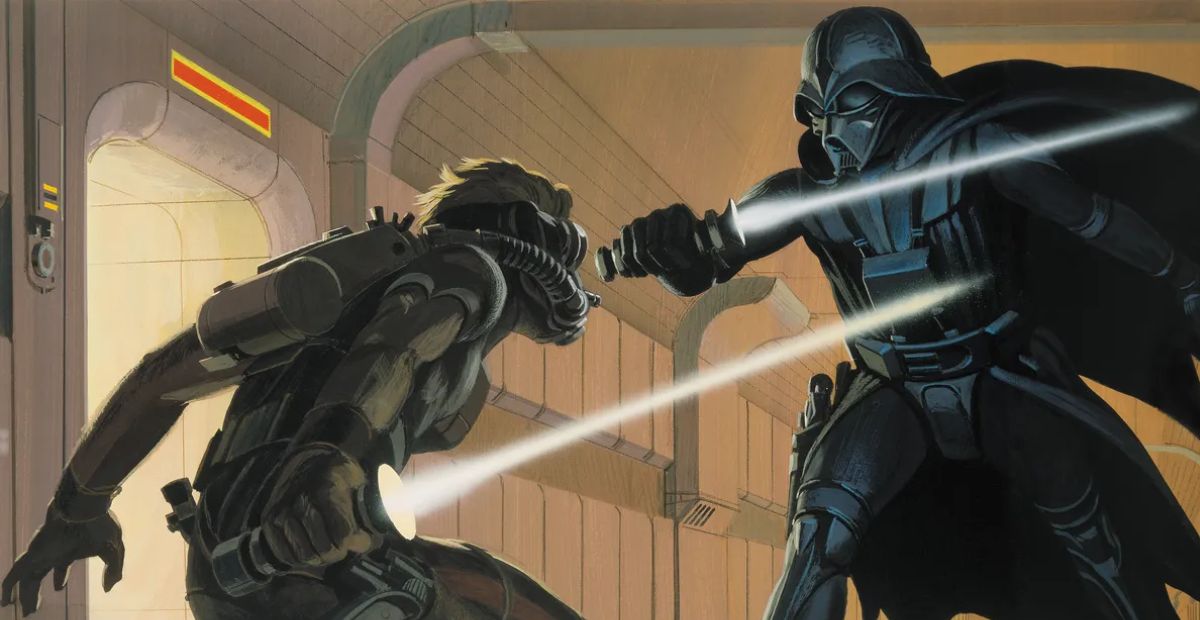When we think of Star Wars villains, the first thing that comes to mind is the look. Darth Vader’s black armor and breathing mask. Maul’s terrifying face tattoos. Kylo Ren’s cracked helmet. But what’s easy to forget is that none of these designs were set in stone from the beginning. Almost every major villain in the saga went through multiple versions—some of them completely different from what we got on screen.
Through concept art, we get to see how these characters evolved—how raw ideas turned into icons. Sometimes, the early designs were unrecognizable. Other times, a single sketch defined the entire tone of a villain. From Ralph McQuarrie’s original work in the ‘70s to the stunning digital concept art of the sequels, the evolution of Star Wars villains shows us how much the visual side of storytelling shapes everything we remember.
1. Darth Maul

Out of all the Star Wars villains, Darth Maul might have the most unforgettable visual design—and it didn’t happen by accident. His final look, with the red-and-black skin, sharp horns, and those piercing yellow eyes, is burned into every fan’s memory. But before he became the Sith assassin we saw in The Phantom Menace, Maul went through a wild evolution in concept art.
According to concept artist Iain McCaig, Maul’s design came from a terrifying place. Literally. George Lucas told him to create something that looked like a living nightmare. So McCaig started sketching twisted, ghost-like figures based on fear and death. One early design looked like a pale-skinned vampire with dark robes. Another had sharp teeth, sunken eyes, and a mouth that looked stitched shut. None of them felt quite right—until McCaig had a personal nightmare of a face staring at him in the dark. He sketched it out immediately. That became the basis for Maul.
2. Count Dooku

When we think of Count Dooku, we picture the calm, commanding Sith Lord played by Christopher Lee—with his curved lightsaber, regal stance, and slow, precise movements. But what’s interesting is that Dooku wasn’t always meant to be that kind of villain. In fact, during the early development of Attack of the Clones, concept artists were exploring very different ideas for who this character could be—and what he might look like.
Before Dooku even had a name, the villain filling his role in the story was more mysterious, more monstrous. Some early designs show him as a twisted, masked figure—closer to a shadowy Sith assassin or even a creature rather than a former Jedi. He was imagined with cybernetic parts, glowing eyes, and alien features. These early versions leaned heavily into the dark, monstrous Sith vibe we saw with Maul. But George Lucas wanted something different for Episode II. He wanted a Sith who felt refined—someone who didn’t look like a brute, but still radiated power.
That’s when the idea of casting Christopher Lee came in. The design shifted overnight. The monstrous elements were dropped in favor of a noble, aristocratic look. His costume became clean, almost Jedi-like, with a dark cape and a high collar. His weapon—the now-famous curved-hilt lightsaber—was designed to reflect his fencing background and precise fighting style, setting him apart from the more aggressive saber users.
3. General Grievous

General Grievous is one of the most intimidating figures introduced in the prequel era—but the design we saw in Revenge of the Sith and The Clone Wars was the result of a long creative process that evolved heavily through concept art. Originally, Grievous wasn’t even supposed to be a cyborg at all.
Early concepts pitched Grievous as a completely alien warlord—no mechanical parts, no split arms, no wheezing cough. Some versions showed him as a hunched, reptilian figure, while others leaned toward insectoid or bone-like designs. The goal was to make him look like a sinister new type of Separatist leader, someone frightening but not connected to the Jedi or Sith visually. But those ideas didn’t feel unique enough. George Lucas wanted something that truly stood out—a villain that looked like a terrifying mix of both technology and death.
That’s when concept artists began exploring the idea of a cyborg general, one who could wield lightsabers despite not being Force-sensitive. This shift led to the first images of a skeletal frame, claw-like feet, and split arms. His head was inspired by kaiju-style monsters, with the final faceplate evolving into something that looked part skull, part droid. Lucas himself requested that Grievous have visible organic features, like his eyes and internal organs, to show he was still alive beneath the armor.
4. Darth Vader

Darth Vader is easily the most iconic villain in Star Wars—and maybe in all of cinema. But his design wasn’t locked in from the beginning. In fact, when concept artist Ralph McQuarrie first began sketching Vader in 1975, the now-famous armor and breathing mask were only meant for one scene.
George Lucas originally described Vader as a dark warrior who would board a ship by jumping through space, moving between vessels during a battle. So McQuarrie added a breathing apparatus and helmet, imagining it like a space suit the character would wear temporarily. The armor was bulky, and the face mask was more samurai-like, almost insectoid in early designs. It wasn’t sleek or polished—it looked like a grim tool for survival.
However, as Lucas developed the story further, the breathing suit concept stuck. Instead of being temporary, it became Vader’s full-time life support system—a result of his injuries on Mustafar. And with that decision, the design shifted from practical to symbolic. McQuarrie refined the helmet into a more stylized, skull-like silhouette, drawing on samurai armor, Nazi helmets, and black cloaks to create a look that radiated fear and control.
5. Jabba the Hutt

In the original script for A New Hope, Jabba was mentioned as a powerful crime lord, but never shown on screen. In fact, when Han Solo confronts Jabba in the original 1977 version, the scene was shot with a human actor—a tall man in a fur-lined vest named Declan Mulholland. At the time, Lucas had no final design for Jabba, and just planned to replace the actor with a stop-motion creature later—which never happened. So for years, Jabba was more of a myth than a physical presence.
Behind the scenes, concept artists explored several versions of Jabba throughout the early development of Return of the Jedi. Some early sketches showed Jabba as a muscular humanoid alien with fins or tentacles. Others made him look more like a hairy beast, closer to a giant rodent or a slug with fur. The design team tried various combinations of animal traits—mixing reptiles, frogs, walruses, and even cats—trying to land on something alien but grounded.
Eventually, Lucas and the design team settled on the now-iconic slug-like body—a massive, slimy torso with stubby arms, a huge mouth, and cold, lidless eyes. Jabba’s final look was built as a massive animatronic puppet, requiring several operators to control his facial expressions, tail, and arm movements. It was a technical marvel for the time, and it worked perfectly. He wasn’t fast, but he didn’t need to be. His presence was enough.
6. Palpatine

Unlike most Star Wars villains, Emperor Palpatine wasn’t designed all at once. His evolution happened slowly, across different films and eras. What we got in Return of the Jedi—a shriveled, ghostly figure in a black cloak—was the result of years of visual experimentation, with concept art that kept shifting depending on how much Lucas wanted to reveal about the character.
In The Empire Strikes Back, Palpatine first appears as a hologram—and the version we see there isn’t even Ian McDiarmid. The original hologram was a strange combination of an old woman’s face superimposed with chimpanzee eyes, giving him an eerie, unnatural look. The idea was to make him feel alien, otherworldly, and not fully human—something that could embody the dark side without being tied to a specific identity just yet.
When it came time to fully reveal him in Return of the Jedi, Lucas and the design team wanted something more grounded—but still unsettling. Early concept art for Palpatine showed him as a gaunt man with an elongated skull, wearing elaborate robes, almost resembling dark royalty. Some designs even leaned into demonic or skeletal features, trying to visualize the dark side’s corruption physically. But in the end, they scaled it back.
Palpatine’s final look—sunken eyes, deep wrinkles, and a simple black hooded robe—was meant to reflect both decay and control. He didn’t need to be flashy. He wasn’t a warrior like Vader or Maul. His power came from the shadows, through manipulation, politics, and fear. Ian McDiarmid’s performance and makeup brought the character to life, giving us a villain who looked ancient, calculating, and quietly terrifying.
7. Kylo Ren

Kylo Ren’s final look is instantly recognizable: a black cloak, a jagged helmet, and that unstable, crackling red lightsaber. But during the early stages of The Force Awakens, concept artists explored a wide range of designs—many of which were very different from what we ended up seeing on screen.
Originally, Kylo Ren wasn’t even named Kylo. Early concept art listed him as “The Jedi Killer,” a shadowy figure tasked with hunting down remnants of Luke’s failed Jedi Order. In these first designs, he looked more like a ghoul or demonic wraith—tattered robes, skeletal armor, and a face hidden beneath a warped, alien-like mask. Some versions gave him glowing eyes, breathing tubes, or even animalistic traits. The goal was to make him look terrifying, not relatable.
But as the character evolved into Ben Solo, the design team shifted direction. They brought in visual echoes of Darth Vader—especially the helmet. J.J. Abrams wanted a mask that felt raw, almost handmade. The final helmet, with its slashed metal and crude construction, symbolized Kylo’s obsession with his grandfather but also his own immaturity. He wasn’t Vader—he was trying to be
8. Snoke

When we first saw Supreme Leader Snoke in The Force Awakens, he felt like a mystery. Giant, scarred, and cold, his design was intentionally unsettling. But that final look came after dozens of concept art variations, each more grotesque than the last.
Some early designs made Snoke look ancient and regal—tall and thin with golden robes and a crown-like headpiece. Others took a more monstrous route: sunken eyes, decaying flesh, and even missing parts of his skull. At one point, there were versions of Snoke that looked completely alien, with elongated limbs, clawed hands, and even reptilian features. The design team went all in exploring how power and time could physically warp a being.
But director J.J. Abrams eventually settled on a design that was more human, but deeply damaged. The final version of Snoke had deep facial scars, a crushed jawline, and a twisted posture—a body barely held together, like someone who had already suffered a massive trauma. His gold robes were a nod to imperial wealth and vanity, but his face told the truth: Snoke was a puppet master, but also a puppet himself.
By the time we reach The Rise of Skywalker, we find out Snoke was engineered by Palpatine, which gives even more weight to his design. He wasn’t a natural being. He was a constructed shell, made to carry out the will of the Sith Eternal. And if you go back and look at his concept art, you can actually see the hints—they were designing a body that looked grown, not born.

